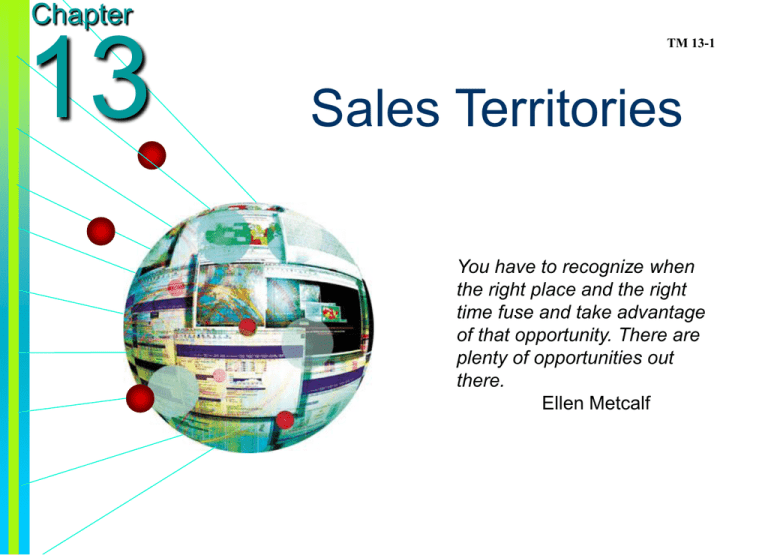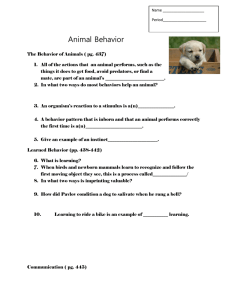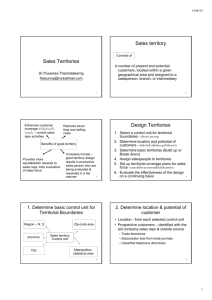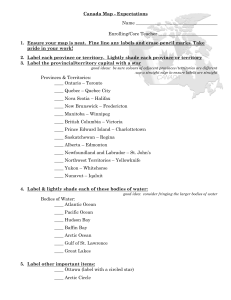
Chapter
13
TM 13-1
Sales Territories
You have to recognize when
the right place and the right
time fuse and take advantage
of that opportunity. There are
plenty of opportunities out
there.
Ellen Metcalf
Copyright © 2003 by The McGraw-Hill Companies, Inc. All rights reserved.
Sales Territory
Comprises
TM 13-2
a number of present and
potential customers, located within a
given geographical area and
assigned to a salesperson, branch,
or intermediary (retailer or
wholesaling intermediary).
Key word: customers
Copyright © 2003 by The McGraw-Hill Companies, Inc. All rights reserved.
TM 13-3
Benefits of Good Territory Design
Enhances
customer coverage
Reduces
travel time and selling costs
Provides
more equitable rewards
Aids
evaluation of sales force
Increases
sales for the sales organization
Increases
morale
Copyright © 2003 by The McGraw-Hill Companies, Inc. All rights reserved.
Procedure for Designing Sales Territories
Select a
Control Unit
Assign
Salespeople to
Territories
Determine Location
and Potential of
Customers
Set Up
Territorial
Coverage
Plans
Copyright © 2003 by The McGraw-Hill Companies, Inc. All rights reserved.
TM 13-4
(Fig. 13-1)
Determine
Basic
Territories
Evaluate
Effectiveness
of Design
Territorial Control Units
States
Counties
Cities
Zip-code
areas
MSAs (Metropolitan Statistical Areas)
Copyright © 2003 by The McGraw-Hill Companies, Inc. All rights reserved.
TM 13-5
Buildup Method of Territorial Design
TM 13-6
(Fig. 13-3)
Management must determine:
Desirable call patterns:
Call frequency per account per year
Total calls needed
in each control group
Workload capacity:
Total calls possible per rep per year =
number of daily calls x days selling
Tentatively set territorial boundary lines
by combining control units until total
calls needed = total calls possible
Modify territories as needed
Copyright © 2003 by The McGraw-Hill Companies, Inc. All rights reserved.
Territory Design: Build-Up Method Worksheet
Control Units
Iowa
Illinois
Customer
class
Call
frequency
Calls
Accounts per year
TM 13-7
Kentucky
Calls
Accounts
per year
Calls
Accounts
per year
A
2 per month
10
240
7
168
5
120
B
1 per month
30
360
17
204
10
120
C
1 every 2 months
68
408
55
330
27
162
108
1,008
79
702
34
402
1,008
+
491
or
402
70%
Iowa
or
100%
Kentucky
Distribution of one rep’s calls
year (1,500)*
Possible control combinations
Alternative territories
100%
Illinois
100% Illinois + 100% Kentucky
100% Illinois + 70% Iowa
*6 calls/day x 5 = 30 calls/week x 50 = 1,500 calls/year
Copyright © 2003 by The McGraw-Hill Companies, Inc. All rights reserved.
Territory Size and Workload Factors
Workload Factor
Territory Size
Increase/Decrease
Nature of Job:
Lots of presale and post-sale activity
Decreases
Nature of product:
A frequently purchased product
A limited repeat-sale
Decreases
Increases
Market development stage:
New market--fewer accounts
Established market--more accounts
Increases
Decreases
Market coverage
Selective coverage
Extensive coverage
Increases
Decreases
Competition:
Intensive
Limited
Copyright © 2003 by The McGraw-Hill Companies, Inc. All rights reserved.
TM 13-8
Decreases – unless
market is oversaturated
Increases
Breakdown Method of Territorial Design
TM 13-9
(Fig. 13-5)
Management must determine
Company sales potential
Sales potential in each control unit
Sales volume expected from
each sales person
Tentatively set territorial
boundary lines by combining
control units total sales potential
= total sales volume expected
Modify territories as needed
Copyright © 2003 by The McGraw-Hill Companies, Inc. All rights reserved.
TM 13-10
Territory Design: Break-Down Method Worksheet
Company sales potential = $200,000,000
Targeted volume rep
= $ 10,000,000
Number of reps needed = Company sales potential = $200,000,000 = 20
Targeted volume/rep
$ 10,000,000
Territory volume as
=
Targeted volume/rep = $ 10,000,000 = 5%
Company sales potential $200,000,000
Each territory should comprise 5% of sales potential or $10,000,000
Combine adjacent control units until each sales potential of $10,000,000
Copyright © 2003 by The McGraw-Hill Companies, Inc. All rights reserved.
TM 13-11
Sales Territories for Pharmaceutical Sales Reps
Divide…
•The 48 states into 5-10 regions
•Each region into several districts
•Each district into 8-12 territories (typically 1 rep per territory)
Copyright © 2003 by The McGraw-Hill Companies, Inc. All rights reserved.
Computers in Territory Design
Geographic
TM 13-12
Information System (GIS)
Combines
multiple layers of information to
provide in-depth understanding of a sales
territory.
Elements
of a complete GIS:
Software
Hardware
Data
Trained
people
Copyright © 2003 by The McGraw-Hill Companies, Inc. All rights reserved.
Routing the Sales Force
Routing
TM 13-13
is the managerial activity that establishes a
formal pattern for sales reps to follow as they go
through their territories.
Reduces travel expenses as it ensures a more
efficient territory coverage.
Area C
Some reps resent it.
Area B
Area A
Best for routine sales
jobs with regular call
x
frequencies.
Area B: Typically the “problem” area.
Copyright © 2003 by The McGraw-Hill Companies, Inc. All rights reserved.







